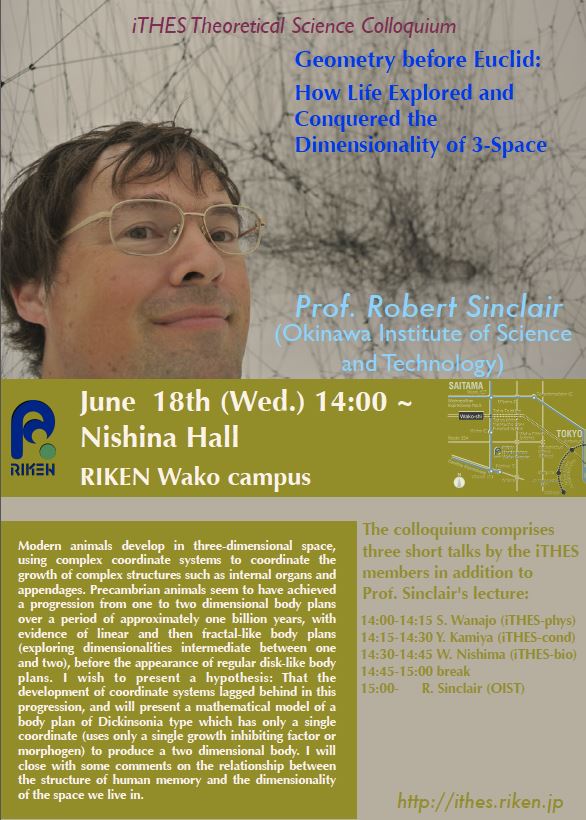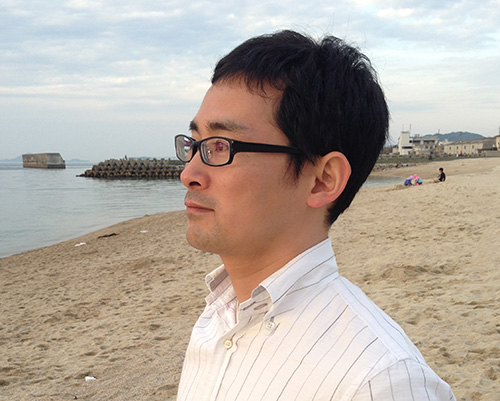|
|
|
|
New Team Leader appointed in iTHES
RIKEN board of executive directors has appointed Dr. Hiro Nagataki
(Astrophysical Big Bang Laboratory, see the photo)
as a new Team Leader of the iTHES Interdisciplinary Mathematical and
Computational Collaboration Team
[ithes-mcc] from June 1, 2014. Hiro replaced Dr. Koji Hashimoto who was
the former team leader of ithes-mcc
and has moved to Osaka University. Koji will still remain as an ithes
associate. I would like to congratulate Hiro for this appointment. I am
pretty sure that this appointment will further accelerate the
interdisciplinary iTHES activities. Also, I would like to thank Koji for
his tremendous efforts to start the iTHES project and to promote
interactions among different disciplines. Tetsuo Hatsuda
|
|
|
Upcoming Events
 |
|
| |
iTHES Colloquium
14:00-, June 18
Nishina Hall
Prof. Robert Sinclair (OIST)
Geometry before Euclid: How life explored and conquered the dimensionality of 3-space
with three short talks by
S. Wanajo (iTHES-phys),
Y. Kamiya (iTHES-cond) and
W. Nishima (iTHES-bio).
iTHES Seminar
Sergei Blinnikov, ITEP/IPMU
What is the Zeldovich number, and what was his life-time favorite problem
Date: 20th June, 14:30-15:30
Place: Room 435-437, Main Research Build.
http://nagataki-lab.riken.jp/Seminar.html
iTHES Seminar
Shigeo Kimura, Osaka Univ.
Effects of High Energy Particles on Accrtion Flows
Date: 20th June, 15:30-16:30
Place: Room 435-437, Main Research Build.
http://nagataki-lab.riken.jp/Seminar.html
iTHES Workshop
iTHES-Kavli IPMU-RESCEU Joint Meeting
7-8 July, 2014
Nishina Hall, Wako Campus
This joint meeting is one of our activities based on the research
partnership MOU
between iTHES and Kavli IPMU .
iTHES Workshop
Supernovae and Gamma-Ray Bursts 2014
Aug.25(Mon)-27(Wed), 2014
Ookouchi Hall
RIKEN Symposium - iTHES workshop on
Thermal Field Theory and its applications
Date: Sep.3(Wed)-5(Fri.), 2014
Place: Ookochi hall
http://www.riise.hiroshima-u.ac.jp/TQFT/
iTHES-IPMU-Osaka Joint Symposium
Nov. 15 (Sat.) 2014 (*** Note that the date has been changed from previously announced Nov.12 ***)
at Kavli IPMU, Univ. Tokyo (http://www.ipmu.jp/ )
|
|
|
Person of the Week
Kiyoshi Yagi
Self-introduction
I am Kiyoshi Yagi, a member of Interdisciplinary Theoretical Biology Team (Sugita group). I received my Ph. D. in chemistry from the Univ. of Tokyo (UT) under the supervision of Prof. Kimihiko Hirao and Tetsuya Taketsugu in 2004. After spending one year in Prof. Kazuo Takatsuka’s group (UT, Komaba) as a JSPS postdoctoral fellow, I became an Assistant Professor back in Hirao group from 2005. I then moved to Univ. of Yamanashi as a Lecturer (2009-2011) and to Univ. of Illinois at Urbana-Champaign as a Research Assistant Professor (2011-2012). I have been appointed Research Scientist in Sugita group since Dec. 2012.
I am originally trained in quantum chemistry or the electronic structure theory of molecules, and have a background in the quantum many-body theory. In my early stage of carrier, I was feeling it’s not chemistry if atoms don’t move. For that reason, I was more interested in quantum phenomena in atomic motion rather than electronic one (I owe a lot to my generous supervisors in this respect), and studied on molecular vibrational states, tunneling effects on hydrogen transfer reactions, and so on. Technically speaking, the pipeline of my research was to export the methodologies matured in the electronic structure to the vibrational structure and reaction dynamics.
Two years in Yamanashi was an intriguing experience, where I worked with “real” chemists to develop High-Performance Fuel Cell. It was an exciting place where many people from various fields made a team for a grand goal: organic/inorganic synthesis, catalysis, surface science, microscopy and spectroscopy, and theorists like me. My main work was to study the mechanism of catalytic surface reaction, but also collaborated with organic synthesis people on finding good molecules for proton-conducting membrane. The experience extremely broadened my scientific view.
In Sugita group, I am developing new methodologies that improve the quality and accuracy of the conventional molecular dynamics (MD). The key element is the modeling of the force field and the incorporation of quantum effects. The short-term goal is to compute the vibrational and/or electronic spectrum of biomolecular systems, which help interpret the experimental measurements, but the long-term vision includes revealing the mechanism of enzyme reactions.
To summarize, I speak and understand most of the language in chemistry and physics. To be honest, I’m not so good at biology, which is a bit shame, but I’m now quickly catching up the important concepts. It is my great pleasure to be a member of iTHES project. I think it’s a wonderful idea to connect the theory and computation in different fields. In fact quantum chemistry has evolved a lot by learning from particle physics. So, why not also biological simulation?
|
|
|
|
|
|


